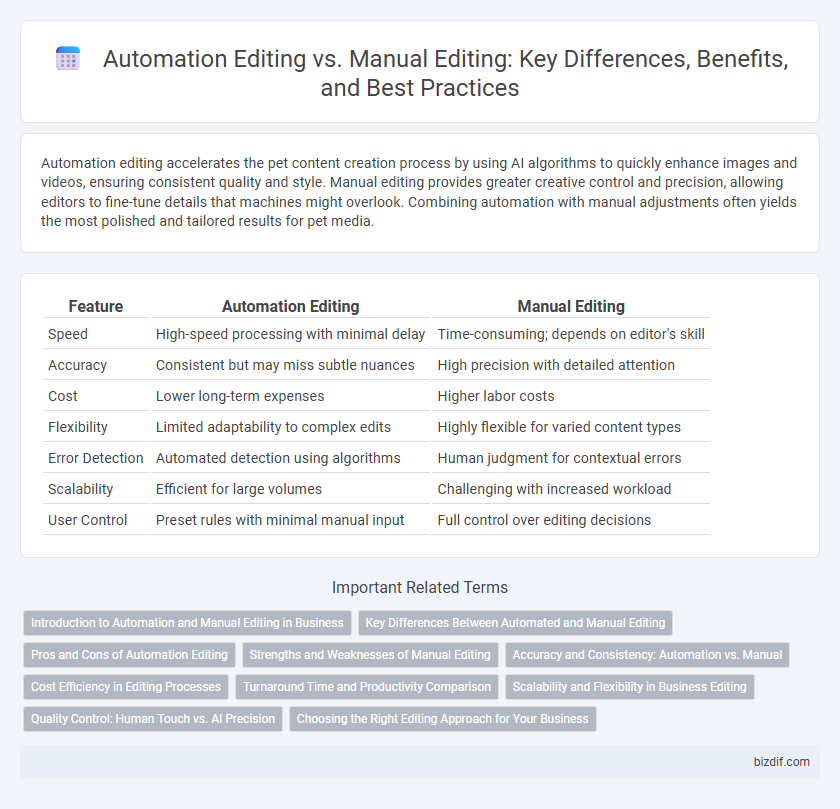Automation editing accelerates the pet content creation process by using AI algorithms to quickly enhance images and videos, ensuring consistent quality and style. Manual editing provides greater creative control and precision, allowing editors to fine-tune details that machines might overlook. Combining automation with manual adjustments often yields the most polished and tailored results for pet media.
Table of Comparison
| Feature | Automation Editing | Manual Editing |
|---|---|---|
| Speed | High-speed processing with minimal delay | Time-consuming; depends on editor's skill |
| Accuracy | Consistent but may miss subtle nuances | High precision with detailed attention |
| Cost | Lower long-term expenses | Higher labor costs |
| Flexibility | Limited adaptability to complex edits | Highly flexible for varied content types |
| Error Detection | Automated detection using algorithms | Human judgment for contextual errors |
| Scalability | Efficient for large volumes | Challenging with increased workload |
| User Control | Preset rules with minimal manual input | Full control over editing decisions |
Introduction to Automation and Manual Editing in Business
Automation editing in business leverages advanced software and artificial intelligence to streamline repetitive tasks, increase accuracy, and reduce turnaround time. Manual editing relies on human expertise for nuanced judgment and creativity, especially valuable in contexts requiring critical thinking and personalized content adjustments. Combining automation with manual editing balances efficiency with quality, optimizing workflows in modern business environments.
Key Differences Between Automated and Manual Editing
Automated editing utilizes algorithms and software tools to quickly identify errors and suggest corrections, significantly increasing efficiency and consistency in text processing. Manual editing relies on human judgment and expertise to assess context, tone, and nuances that automated systems may overlook, ensuring higher accuracy and personalized content quality. Key differences include speed, precision in contextual understanding, and the ability to handle subjective or complex linguistic elements.
Pros and Cons of Automation Editing
Automation editing accelerates workflow by using AI algorithms to quickly analyze and sort vast amounts of footage, enhancing efficiency and consistency in video projects. Limitations include reduced creative control and the potential for overlooking nuanced storytelling elements that only human editors can identify. Relying solely on automation may result in generic edits lacking emotional depth and personalized style essential for engaging content.
Strengths and Weaknesses of Manual Editing
Manual editing offers precise control over content, enabling nuanced adjustments tailored to specific contexts, which automated tools may overlook. It allows for critical thinking, creativity, and subjective judgment necessary for quality refinement and tone consistency. However, manual editing is time-consuming, prone to human error, and less efficient for processing large volumes of text compared to automation.
Accuracy and Consistency: Automation vs. Manual
Automation editing leverages advanced algorithms to enhance accuracy by detecting errors and inconsistencies consistently across large volumes of text, reducing human oversight and fatigue. Manual editing relies on human judgment and intuition, allowing for nuanced understanding but introducing variability and potential oversight due to fatigue or bias. Combining automation with manual review often yields optimal results, maximizing both precision and contextual sensitivity in the editing process.
Cost Efficiency in Editing Processes
Automation editing significantly reduces labor costs by accelerating repetitive tasks, allowing editors to allocate time to higher-impact creative decisions. Manual editing incurs higher expenses due to the need for skilled personnel handling detailed adjustments and quality control. Integrating automation tools enhances cost efficiency while maintaining accuracy and consistency in editing workflows.
Turnaround Time and Productivity Comparison
Automation editing significantly reduces turnaround time by processing large volumes of content rapidly with consistent accuracy, enhancing overall productivity. Manual editing, while offering nuanced judgment and creativity, typically requires more time and labor, causing slower project completion. Integrating automation tools with manual review optimizes workflow efficiency and quality control in editing projects.
Scalability and Flexibility in Business Editing
Automation editing offers unparalleled scalability, allowing businesses to process large volumes of content efficiently with consistent quality. Manual editing provides greater flexibility by enabling nuanced judgment and customized adjustments tailored to specific contexts or client preferences. Combining both approaches can optimize scalability while maintaining editorial precision in dynamic business environments.
Quality Control: Human Touch vs. AI Precision
Automation editing leverages AI algorithms to deliver consistent quality control by quickly identifying errors and ensuring uniformity across large volumes of content. Manual editing provides a human touch, capturing nuanced context, emotional tone, and subtle language intricacies that AI might overlook. Combining AI precision with expert human judgment enhances the overall quality and reliability of the editing process.
Choosing the Right Editing Approach for Your Business
Automation editing enhances efficiency by leveraging AI-driven tools to quickly identify errors and ensure consistency across large volumes of content. Manual editing allows for nuanced judgment, capturing stylistic subtleties and context that technology might miss, making it ideal for high-stakes or creative materials. Selecting the right editing approach depends on factors such as content complexity, turnaround time, budget constraints, and the desired level of precision in your business communications.
Automation Editing vs Manual Editing Infographic

 bizdif.com
bizdif.com